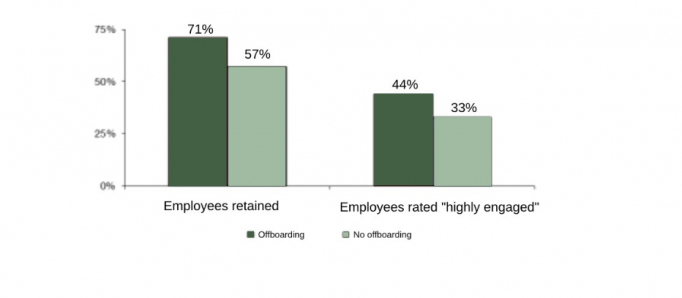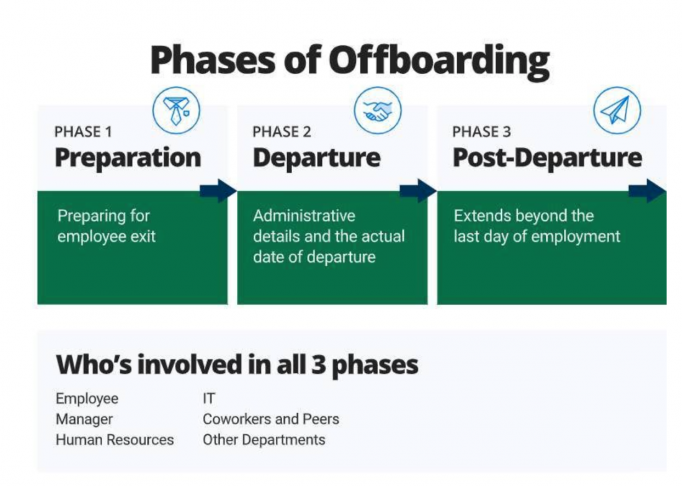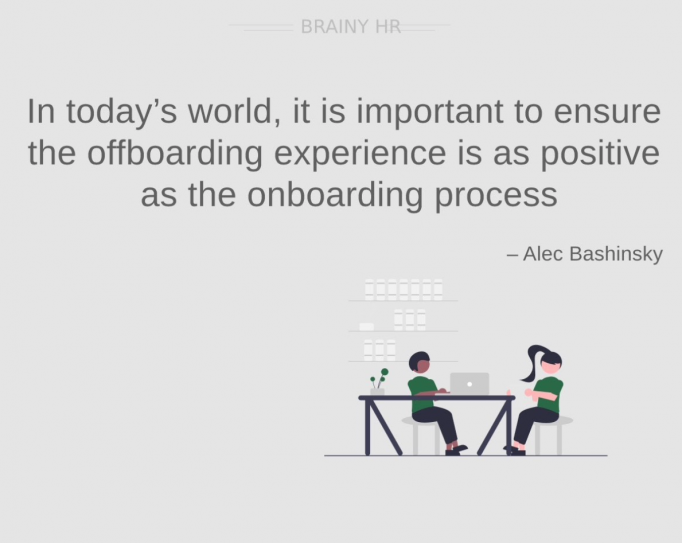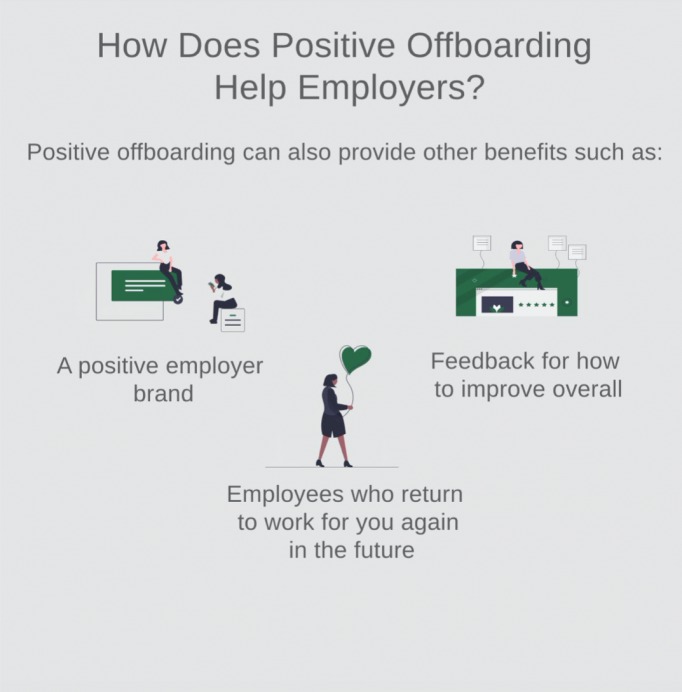The first thing you need to realize is that the offboarding path should be identical for every employee regardless of their position and length of service. There are several definitions of offboarding. The simplest one says that these are all processes and decisions that take place when an employee leaves the organization. The problem is that very often this procedure does not exist or is neglected. So how to prepare for this process to be able to conduct it professionally? Here are some proven tips that should help you with employee offboarding checklists. Moreover, according to the same survey, only 14% of managers believe that the offboarding employees process that operates in their organization is effective.
Offboarding is the process of the employee separating from the organization. It plays a huge role in building experiences and memories related to the employer. How to do good offboarding? And is it worth investing in?
As employees of HR departments, we are aware of the importance of a well-organized onboarding process, i.e. welcoming a new employee and implementing him in his duties. Unfortunately, we do not pay so much attention to the issue of saying goodbye to an employee. Why is the often-overlooked offboarding practices so important? How to carry it out and what elements of the process should be paid attention to and what is offboarding in human resources? You will find the answers in our article.
What Is Employee Offboarding?
Employee offboarding is the name of the process of the employee's separation from the organization. It collects all the procedures and rules related to saying goodbye. Unfortunately, according to Aberdeen research, only 29% of organizations have a formalized offboarding procedure!

This means that only 1 in 3 organizations remembers the role that endings play in human life.
Employees Offboarding Checklist: Step-By-Step Guide for HRS
Employee offboarding is not just a conversation with an employee. It is a 6-step offboarding best practices process. The outgoing employee's experiences depend on the proper addressing of each of them. The Offboarding program consists of 6 stages. To take care of the experiences of the departing employee, you need to address each of them. A long-standing employee resigns. You are surprised, you did not expect that. But you will quickly find yourself thinking about what steps you need to take to make the offboarding process as efficient as possible. BrainyHR created an employee offboarding process checklist, so the main phases of Offboarding by smartsheet.

Step1 - Communicate quickly
Even if all the details regarding the exit have not been clarified, you should not wait too long to let the other employees know about this change. Nothing fuels the spread of misinformation like uncertainty. You should, therefore, inform other managers and the HR department of the termination as soon as possible so that this information can be communicated quickly and the emergence of rumors can be prevented.
The best thing to do is to send a formal email in which you wish the employee all the best and, if necessary, also state the reason for the termination. Also mention that the employees can contact the respective manager or the HR department at any time if they have any questions. The IT department is then informed to get the offboarding process rolling.
Step 2 - Prepare documents
A termination is always associated with bureaucratic effort. The following documents are particularly important:
-
Notice of withdrawal or termination
-
Non-disclosure and non-competition clause (if necessary)
-
Benefits documents (explanation of current benefits, unemployment insurance, etc.)
Protect yourself against legal problems by documenting the entire process and saving all documents as copies. For example, a signed letter of resignation will protect you from disgruntled victims who claim they were not informed of their release.
Step 3 - Initiate knowledge transfer
In the event of a termination, companies not only lose the employee themselves, but also the knowledge and skills they have built up in the company. If you don't want to invest a lot of time in training your successor or if you even want to lose the know-how completely, you should initiate the knowledge transfer as soon as possible. This ensures that all relevant information is retained by the company.
In a conversation with the departing employee, you should clarify these questions, among other things:
-
Can your everyday life be divided into individual steps?
-
Do some projects repeat themselves? (e.g. weekly, monthly, etc.) If so, which ones and how are they prepared?
-
Which files does your successor need to have access to?
-
In which systems does your successor need training?
-
Which contact persons outside and within the company must be informed about the change?
-
Which tasks have priority?
Step 4 - Communication of change
When talking about offboarding, we usually focus on the person who leaves the organization. The remaining employees are equally important in this situation.
After all, the company will expect them to be fully committed, to take over the responsibilities of people who are no longer in the company. Lack of full information on personnel changes may make it difficult for them to continue their work, and in extreme cases discourage them from being associated with the organization for longer.
We can be sure that any inconsistency on the part of the employer will be immediately explained by the employees themselves… by word of mouth. The team of the leaving employee should be informed:
-
about the reasons for breaking up,
-
about key dates (e.g. until when is the person at work?),
-
how the handover process will be,
-
what steps the employer will take regarding the vacant job.
If possible, it is also worth ensuring a warm, less formal farewell of the employee (if you are looking for inspiration, see the BrainyHR blog).
Step 5 - Delegation of responsibilities
Handing over the responsibilities of the outgoing employee is crucial to maintaining business continuity. Unfortunately, often each outgoing employee has an approach to handover, which makes it difficult to keep going smoothly. I encourage you to teach employees how to transfer their duties, or at least make it easier for them thanks to ready-made forms or employee offboarding checklist with elements that should be included in a good transfer. These include, among others:
-
description of current projects in which he was involved and a list of the most urgent tasks to be implemented,
-
key contact persons (inside and outside the organization) - it is worth for the employee to personally introduce them to the employees who will stay in touch with them after leaving the company,
-
documents, systems, resources, tools to which only the outgoing person has access or administrative rights.
Step 6 - Final exit interview
An exit interview should be part of the employee offboarding procedure. If the employee quit because of dissatisfaction or a conflict, a clarifying discussion can help to avoid such situations in the future. However, the direct manager should not conduct the interview alone - it is best to involve a neutral person, such as the HR manager. If criticism is expressed, you should take it seriously.
An exit interview is nothing else than a summary interview (individual interview) that is conducted with an employee leaving the company. It is worth conducting it regardless of whether the decision to part was taken by the employer or the employee. If conducted in the right way, it allows you to collect valuable feedback from the departing employee and introduce changes in the organization.
An exit interview should be conducted by an HR employee or an external person. As with any other research interview, it is good for the questions contained in it to be open-ended, which makes it easier to deepen them. It is worthwhile for the exit interview to cover such areas as:
-
reasons for leaving the organization,
-
job satisfaction level,
-
satisfaction with working conditions and non-wage benefits,
-
relations with the boss, closest team and further colleagues,
-
development opportunities within the organization,
-
organizational culture and work environment,
-
company policy and procedures,
-
the employee's willingness to recommend the company as an employer in the future.
It is not always possible to conduct an exit interview in the form of an interview. In such a situation, it is worth ensuring a shorter, electronic version of the survey in the form of an online survey.
Here are some sample questions:
-
Did the job meet your expectations?
-
Did you have the resources to get your job done?
-
Would you recommend our company to your friends? Why or why not?
-
What could we have done to convince you to stay?
-
How would you describe the relationship with your direct manager?
-
How can we improve ourselves?
Automate your offboarding process
Start working with Brainy HR that can provide everything you need to make your employees happy!
Step 7 - Reclaim Company Property
Don't forget to reclaim company property when you say goodbye to an employee. These can be cell phones or laptops, but also keys, ID cards, or security cards. Any company credit cards and expense accounts in the name of the employee concerned must be closed immediately.
Step 8 - Goodbye
Every employee, especially long-term employees, deserves a personal farewell, at which the employer officially thanks one last time for the cooperation.
Hold a party where the rest of your colleagues have the opportunity to say goodbye in a casual setting. The employer should also be present and say a few words to say goodbye. The speech must by no means sound artificial - one should strive for authenticity and ignore embarrassing or unpleasant stories.
The parting party serves primarily to highlight the performance of the departing employee. Show that you still appreciate him, support him in his endeavors, and are grateful for the time he has spent in your company. This way you will be remembered positively not only for former employees, but also for current employees.
Step 9 - Leave the door open to return
Indeed, it rarely happens that ex-colleagues return to the company. But one should never say never and above all not close oneself to the possibility. The so-called boomerang employees have the advantage of not having to retrain from scratch because they are already familiar with the company. You would, therefore, do well to stay in contact with the person concerned, for example via online networks.
Step 10 - Administrative matters on the last day of work
A checklist (available for both the employee and his manager) will help you understand reality. The final set of things to do will certainly depend on the specifics of a given organization, but it should include:
-
returning keys/access cards,
-
returning a laptop or business smartphone,
-
return of the company car and its documents,
-
transfer of documents or access to documents (paper and virtual),
-
reminder to take personal belongings.
An inseparable element of offboarding is blocking access and replacing the employee's e-mail box and reporting his resignation from the benefits of functioning in the company.
Removing an employee from subscription lists, newsgroups, or company structures while the employee is still formally a member of the team may be perceived negatively.
Step 11 - Communication with the alumnus
I believe that the last element of offboarding should be inviting an employee to the alumni program. This is important because keeping in touch with your former employees can bring many benefits to employers. Their impact on the image or recruitment activities, including reaching new talents, is huge (and completely unused).
5 Tips for Offboarding an Employee

Usually, HR dont know how to manage employee offboarding and main tips.When a new employee starts his job, he receives a lot of attention. Employers try to make newcomers feel welcome and integrate them quickly into the team - in the hope that they will stay with the company for the long term. While a fair amount of time is usually invested in proper onboarding, the offboarding process is often devoted to much less care. A well-thought-out offboarding strategy can significantly improve a company and its culture:
# 1 investment in the future
The shortage of skilled workers is a problem for many companies when looking for new employees. It is all the more important that both existing and former employees perceive their employer positively. If you can win over your employees as brand ambassadors who express themselves in their environment about your company in a friendly manner or even encourage acquaintances to apply, this can support you in recruiting. A pleasant offboarding also shapes the impression you make on your employees. So a good reason to think hard about this topic.
# 2 Positive message to employees
How do you usually react when an employee informs you of their intention to leave the company? From this point on, do you treat him like air and punish him for his decision? If so, you should rethink your behavior as soon as possible. Put yourself in the position of your employee: He may have worked for you for years, but now has the need to develop in a completely different direction and knows that he would regret it if he did not follow his gut feeling.
Instead of the evil looks, give flowers or chocolates as gifts. Thank you in a joint final round for your work and wish the departing employees all the best for their future. In this way, you signal to the rest of the workforce that no resignations will be held against anyone, even if it means a loss for the company.
# 3 chance for reflection
Every good offboarding includes a final exit discussion in which both parties can give each other feedback. Never forget: No company is perfect and a successful employer brand is not a state, but a process. Therefore, have an open ear for your employees, including those who leave the company. Get feedback and try to implement any suggestions wherever possible. This will improve the work situation for current and future employees alike and show that you are open to change.
# 4 Concession for those left
When an employee leaves, the tasks he originally performed are distributed among his colleagues. The increased workload is certainly no reason to be happy, as you probably have your hands full yourself. Make sure handovers are carried out properly and that the remaining workers are not left behind without sufficient background information and briefing. In this way, projects can be taken over without any noticeable breaks and subsequently processed.
# 5 Employer and company brand
Don't forget that each employee becomes an ambassador for your brand, both for the product and the employer. When an employee leaves the company of his own free will - enjoy his happiness. Collect on a farewell card the signatures of people with whom the departing person cooperated and organize a farewell meeting so that the employee who leaves feels that he was an important part of the company. When it is you firing an employee, regardless of the reasons for your decision, reassure him of your full support and assistance in obtaining references or looking for a new job. Regardless of the situation, do not forget to thank you for the cooperation, the time spent together and involvement in the daily life of the company, after all, for many of us it is like a second home.
The term offboarding, like onboarding, in the context of an employee can be referred to as traveling by plane and translates as being off-board and onboard our company. However, we should remember that this journey should always end with a soft landing, by the specified procedures.
Conclusion
Parting with an employee is never easy. The better the offboarding is planned, the calmer all parties go through this situation. Each company should adapt its offboarding standard to its organizational culture. When creating your process, it is worth taking a look at what onboarding looks like in the company - contrary to appearances, both processes have a lot of similar elements that simply work "the other way". Automated employee offboarding workflow, for example - BrainyHR can help you with the offboarding process. Therefore, if onboarding is functioning well in our organization, and offboarding is still in its infancy, on this first process, let's build a template for an effective parting with employees. In BrainyHR we have templates with an offboarding process, you can use our process or make your own. Just try, and see how it simplifies your HR functions.



 Posted on Sep 15, 2020 by Anna
Posted on Sep 15, 2020 by Anna


